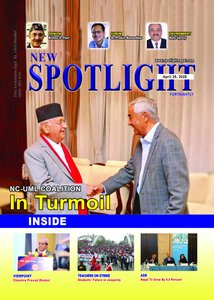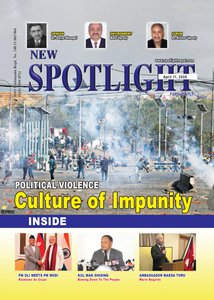Our Terai is primarily a agricultural region of our country. According to innumerable past studies, the future economic sustainability of our Terai is going to be very much dependant on adjoining mid hill regions for replenishment of constantly depleting water supply from the existing water sources, which are already gradually drying up.
On top of the above explained dependency, the 2008 Kosi flood disaster has amply demonstrated that in future even the physical existence of some region of our Terai might very well depend on comprehensive planning of water resource in hill region discarding significant project benefits. It has been clearly explained by all concerned scientists and engineers that the solution to avert even far greater flood disasters in future requires the implementation of the Kosi storage dam project that involves submergence of vast areas of fertile valleys in the hill at great sacrifice to the interest of the people in mid hill region.
Grave Ignorance
Unfortunately in recent years even the concerned policy makers and planners do not seem to realize the full significance of our water resources for our own country particularly its critical importance to some of our geographical regions. Thus it is quite understandable that our country’s political leaders appear not to know much about important aspects of our water resources more specifically about the future dependency on mid hill for supply of water for irrigation in Terai along with flood control.
It will be the greatest injustice to the people of Terai if the mid hill is detached from the Terai region in future restructuring of the provincial boundaries, which would prompt to advancing water resources development strategy to maximize benefits accruing exclusively to mid hill region totally disregarding the interest of the Terai. Under certain condition such one-sided planning could even be disastrous to Terai.
Consequences of Inter States Rivalry
Demand for water worldwide and also in our region is rapidly growing as a result it is becoming increasingly scarce. Water has already become a valuable export item. In our Indian Sub-continent conflict among the states of country have greatly hampered development of water resources. India was easily able to resolve international water dispute over Indus and Ganges with Pakistan and Bangladesh respectively but conflicts among its states still remain fully unresolved. The well known cases of such conflict among Indian states are related to Godavari, Cauvery, Krishna and Narmada rivers.
Depletion of Surface Water
The water resources of Terai is being depleted due to the main following reasons:
(1) There was a rampant deforestation in the past across the entire Terai region and its adjoining Churia area. This has led to gradual drying up of the local rivulets and streams that were traditionally the source of local irrigation. Contrary to it, area under cultivation has greatly increased due to deforestation, which has led to increase in demand for water needed to irrigate new lands.
(2) There is rapid growth of population in the upper catchment areas of small and medium sized rivers directly flowing into Terai from the hill areas. The flow of these rivers is being increasingly used in the hill region itself during the dry season since a long time with the result that the dry season flow of such rivers in Terai is constantly decreasing.
UNDP/FAO Studies
Since 1960s several detailed studies have been conducted to recommend ways to resolve water supply to irrigate on a large scale Terai lands. These studies were conducted by UNDP/FAO for area between Parsa and Saptari (by diverting Sun-Kosi river); West German Govt. and ADB for Jhapa; Rupandahi and Nawal Parasi by UNDP (by diverting Kali Gandaki river); Kapilvastu and Banke by West German agency (by diverting West Rapti river); Bardia, Kailali by ADB, JICA and World Bank (by diverting Bheri river along with irrigation drawing directly from the Karnali storage dam project). With the exception of irrigation in Jhapa and irrigation drawing water directly from the Karnali storage dam project, all other proposed schemes involve diversion of water from the mid hill by long tunneling across high mountains.
Imminent Kosi Flood Disaster
All rivers flowing from hills are liable to flooding in Terai resulting in some cases great losses. Kosi flood losses of all such cases acquire international significance because of the enormity of past and the imminent losses of life and property.
Kosi river known as the sorrow of Bihar in the past had shifted from east to west over 70 miles within a period of 200 years. The shifting of the river course was accompanied by big loss of life and property. However, the embankments built about 50 years ago has come as a great relief by preventing lateral shifting of the river course.
At present Kosi river channel bed is well above the surrounding grounds due to continued siltation. The embankment have already outlived their useful life. We have already witnessed enormous loss of life and property in 2008 breach of Kosi embankment when the flood discharge was only about 1 ½ lack cusecs, where-as extremely high flood discharge of almost nine lacks cusecs have already been measured twice within a time interval of 10 years about fourty years ago when river bed siltation had just started. After that the flood discharge was mostly below 5 lacks cusecs. Well known expert on Kosi Sir Claude Inglis has predicted that during the extremely high flood the Kosi would break away from its present course right away near Chatra breaching the eastern embankment.
It is known from the experience of China that the loss of life and property would be catastrophic if the river flowing on highly elevated bed spills across the embankment at the time of extremely high flood discharge. It is reported that the loss of life of people each time exceeded one million when the Yellow river embankments were breached during very high floods of 18 87 and 1931.
It is necessary to implement Kosi storage dam project to save the life and property of millions living in Sunsari and Morang
Sacrifice of Mid Hill Interest
Nepal’s water resources development planning inclusive of tunneling to divert water to irrigate land in Terai will be more costly and at the same time the power generation potential will also be reduced by comparison to alternative variant earmarked exclusively for power generation. Provision of large storage dam necessary for flood control in Terai will have devastating economic as well as environmental consequences for the people of mid hill. Just in one single Karnali Chisapani storage project case, the land area under submergence will exceed 40,000 hectares.

Dr. A.B. Thapa
Thapa writes on water resources issue
- Dudhkosi Multipurpose Project
- Jul 11, 2022
- Dudh-Kosi Power Project And Kosi Treaty
- Sep 27, 2021
- Uttarakhand Glaciers And Recent Disaster: A Lesson To Our Country
- Mar 02, 2021
- Multipurpose Langtang After Melamchi: Inter-Basin Water Transfer
- Nov 04, 2020
- Large Storage Dams Projects Wary of Giving Away Children’s Inheritance
- Dec 22, 2019














